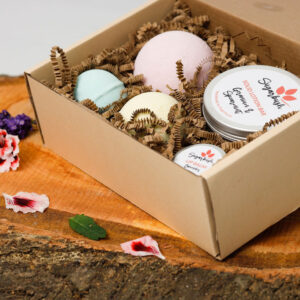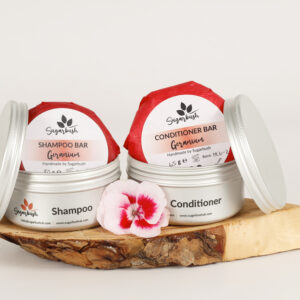A good skincare routine doesn’t have to be complicated. By choosing natural ingredients and following a few simple steps, you can nourish your skin while avoiding harsh chemicals. Whether you’re just starting out or ready to switch to a more natural approach, this guide will help you build an effective routine that’s easy to maintain.
Why choose a natural skincare routine?
Many conventional skincare products contain synthetic ingredients, fragrances and preservatives that can irritate the skin or disrupt natural balance. A natural skincare routine focuses on gentle, plant-based ingredients that support healthy skin without unnecessary additives. Using natural products can help:
• Reduce irritation and sensitivity
• Maintain the skin’s moisture barrier
• Support long-term skin health
• Minimise environmental impact
So, how do you achieve a simple yet effective natural skincare routine? There are three steps to get you on the road to fantastic skin: cleansing, toning and moisturising. To get the most from these steps, it’s best to do these twice a day – once in the morning and once at night. Let’s dive a little deeper into what these steps involve.
Step 1: Cleansing – remove impurities without stripping the skin
Cleansing is the foundation of any skincare routine. It removes dirt, excess oil and pollutants that build up throughout the day or night. When choosing a natural cleanser, look for ingredients like:
• Aloe vera – Soothes and hydrates while gently cleansing.
• Chamomile – Helps calm redness and irritation.
• Honey – Has antibacterial properties and locks in moisture. Cosmetic grade honey is also a humectant which attracts moisture to the skin.
Avoid harsh foaming cleansers as these can strip the skin’s natural oils. Natural surfactants like Cocamidopropyl betaine, Coco glucoside or Sodium cocoyl isethionate are milder and obtained from nature. They’re ecofriendly too!
You might need to try a few different types of cleanser to find the one that works best for your skin. For example, there are gentle foaming washes, cleansing balms, cream cleansers or oil cleansers. It might sound counterintuitive, but oils can be incredibly effective at cleansing—so don’t be afraid to give them a go! All these varieties do the same job but your skin may react better to one over another.
To cleanse naturally:
• Wet your face with lukewarm water.
• Apply a small amount of your chosen cleanser to your face using circular motions.
• Rinse thoroughly and pat dry with a clean towel.
NB: if you decide to try an oil cleanser, you won’t need to wet your skin first, just get straight to it. Follow the guidance on the product if you’re unsure.
Step 2: Toning – balance and refresh your skin
A natural toner is a fantastic addition to your skincare routine. They help remove any leftover residue after cleansing and prepare your skin for moisturiser. Toners help to deeply hydrate your skin and can vary from simple floral waters (hydrosols) to more complex formulations with active ingredients. Aside from their hydrating properties, they can also be a great astringent that helps tighten pores and refine the skin’s surface.
Look for toners with:
• Rose water – Hydrating and soothing.
• Witch hazel – Helps tighten pores and control oil (best for oily skin).
• Green tea – Packed with antioxidants to protect the skin.
• Aloe vera – Extracts are known to promote skin repair and also contains polysaccharides to improve skin hydration.
• Glycerine – This can either be listed as Glycerine or an ingredient that has Glycerite in the name. If it’s a glycerite, it’s a botanical ingredient that has been added to glycerine e.g. cucumber glycerite.
• Hyaluronic acid – Has excellent water binding properties so helps improve skin appearance.
If you want to keep it really simple, you can buy one hydrosol and see how your skin reacts. Rose, Chamomile or Neroli are all great options and suit most skin types.
To tone naturally:
• Apply a few drops of toner to a cotton pad or reusable equivalent. You can also pour a small amount directly into your palms and apply to your face if you want to avoid cosmetic pads altogether.
• Gently press onto your face, avoiding the eye area.
• Allow it to absorb before moving to the next step.
Step 3: Moisturising – lock in hydration
Moisturising is essential for keeping your skin soft, hydrated and protected from the elements. Great natural moisturisers include:
• Shea butter – Rich and deeply hydrating.
• Jojoba oil – Lightweight and suitable for all skin types. Jojoba is technically a liquid wax and its composition is remarkably similar to your skin’s natural oils – making it a brilliant match for most skin types.
To moisturise naturally:
• Take a small amount of moisturiser and warm it between your fingers.
• Gently press or massage into your skin.
• Allow it to absorb before applying makeup or sunscreen.
Already got these mastered? If you want to add extra nourishment to your routine, consider incorporating these natural treatments.
Exfoliation – Buff away dead skin cells
Exfoliation helps remove dead skin cells, unclog pores and improve skin texture. However, over-exfoliating can cause irritation, so it’s best to exfoliate a maximum of 1-2 times per week depending on your skin type.
Natural exfoliants include:
• Oatmeal – Gentle and soothing, great for sensitive skin.
• Clays – packed with minerals to give your skin a boost while providing gentle exfoliation. They’re also great at detoxifying and helping control excess oil production.
• Sugar or salt scrubs – Help slough off dead skin without harsh chemicals.
To exfoliate naturally:
• Do step 1 as above.
• Apply a small amount of exfoliator to damp skin.
• Gently massage in circular motions.
• Rinse with warm water and follow with step 2 and 3 of your routine.
Additional moisturisation – Facial oils
Facial oils can boost hydration and provide essential nutrients. Some of the best options include:
• Rosehip oil – Helps improve the appearance of scars and fine lines. Also known to help reduce hyperpigmentation.
• Argan oil – Balances oil production and adds radiance. Contains linoleic acid which helps to improve skin elasticity in mature skin. Can be blended with Rosehip and Evening Primrose oil.
• Evening Primrose oil – A fast absorbing oil rich in unsaturated fatty acids and tocopherols, particularly good for dry, acne-prone or irritated skin.
Sun Protection – Protecting skin from the elements and premature ageing
One of the most important steps in any skincare routine is sun protection. Even on cloudy days, UV rays can damage your skin and lead to premature ageing.
For a natural approach to sun care, look for mineral-based sunscreens with zinc oxide or titanium dioxide, which provide broad-spectrum protection without harmful chemicals.
Final Thoughts
Creating a natural skincare routine doesn’t have to be complicated or expensive. By focusing on gentle, plant-based ingredients and listening to your skin’s needs, you can achieve a healthy, glowing complexion without relying on synthetic chemicals. And remember – skincare isn’t just about what you put on your skin. What you eat and drink matters too. Drink plenty of water and eat a balanced diet rich in vitamins A, C, and E to support healthy skin from within.
Remember, skincare is personal—what works for one person may not work for another. Experiment with natural ingredients and find what suits your skin best.
Are you transitioning to a natural skincare routine? Share your favourite natural skincare tips on our social media platforms.






